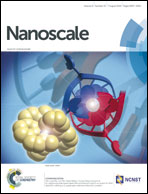Functional investigations on embryonic stem cells labeled with clinically translatable iron oxide nanoparticles†
Abstract
Stem cell based therapies offer significant potential in the field of regenerative medicine. The development of superparamagnetic iron oxide (SPIO) nanoparticle labeling and magnetic resonance imaging (MRI) have been increasingly used to track the transplanted cells, enabling in vivo determination of cell fate. However, the impact of SPIO-labeling on the cell phenotype and differentiation capacity of embryonic stem cells (ESCs) remains unclear. In this study, we wrapped SPIO nanoparticles with stearic acid grafted PEI600, termed as Stearic–LWPEI–SPIO, to generate efficient and non-toxic ESC labeling tools. Our results showed that efficient labeling of ESCs at an optimized low dosage of Stearic–LWPEI–SPIO nanoparticles did not alter the differentiation and self-renewal properties of ESCs. The localization of the transplanted ESCs observed by MRI correlated well with histological studies. These findings demonstrate that Stearic–LWPEI–SPIO nanoparticles have potential to be clinically translatable MRI probes and may enable non-invasive in vivo tracking of ESCs in experimental and clinical settings during cell-based therapies.


 Please wait while we load your content...
Please wait while we load your content...